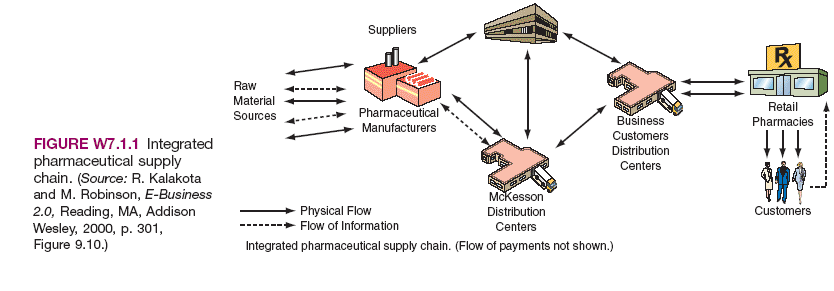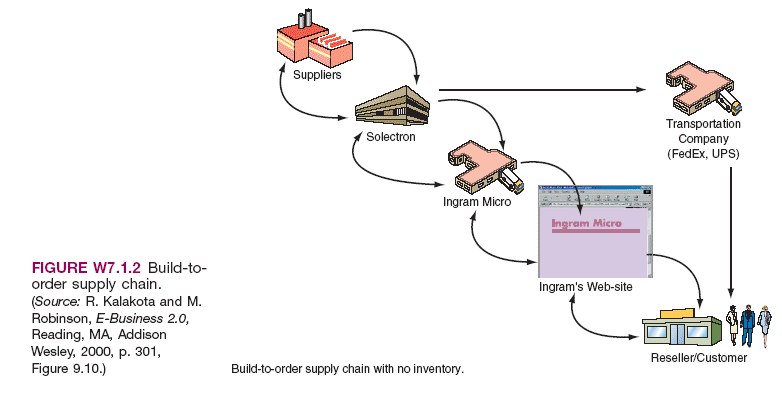Online File W7.1
TYPES OF SUPPLY CHAINS
The supply chain is typical for a manufacturing company. If the
company is a traditional one, it will produce items that will be stored in
warehouses and other locations, making the supply chain more complex. If the
company uses a make-to-order business model, there will be no need for storing
finished products, but there will be need to store raw materials and components.
Therefore, it is clear that supply chains depend on the nature of the company.
The following four models are very common: integrated make-to-stock,
build-to-order, continuous replenishment, and channel assembly.
INTEGRATED MAKE-TO-STOCK MODEL
The integrated make-to-stock supply chain model focuses on tracking
customer demand in real time, so that the production process can restock the
finishedgoods inventory efficiently. This integration is often achieved through
use of an information system that is fully integrated (an enterprise system).
Through application of such a system, the organization can receive real-time
demand information that can be used to develop and modify production plans and
schedules. This information is also integrated further down the supply chain to
the procurement function, so that the modified production plans and schedules
can be supported by input materials.
An example of integrated make-to-stock is Starbucks Coffee (starbucks.com).
Starbucks uses several distribution channels, not only selling coffee drinks to
consumers, but also selling beans and ground coffee to businesses such as
airlines, supermarkets, department stores, and ice-cream makers. Sales are also
done through direct mail, including the Internet. Starbucks is successfully
integrating all sources of demand and matching it with the supply by using
Oracleís automated information system for manufacturing (called GEMMS). The
system does distribution planning, manufacturing scheduling, and inventory
control (using MRP). The coordination of supply with multiple distribution
channels requires timely and accurate information flow about demand,
inventories, storage capacity, transportation scheduling, and more. The
information systems are critical in doing all the above with maximum
effectiveness and reasonable cost. Finally, Starbucks must work closely with
hundreds of business partners.
BUILD-TO-ORDER MODEL
Dell Computer is best known for its application of the build-to-order
model. In this model the company begins assembly of the customerís order almost
immediately upon receipt of the order. This model requires careful management of
the component inventories and delivery of needed supplies along the supply
chain. A solution to this potential inventory problem is to utilize many common
components across several production lines and in several locations.
One of the primary benefits of this type of supply chain model is the perception
that each customer is receiving a personalized product. In addition, the
customer is receiving it rapidly. This type of supply chain model supports the
concept of mass customization.
CONTINUOUS REPLENISHMENT MODEL
The idea of the continuous replenishment supply chain model is to
constantly replenish the inventory by working closely with suppliers and/or
intermediaries. However, if the replenishment process involves many shipments,
the cost may be too high, causing the supply chain to collapse. Therefore very
tight integration is needed between the order-fulfillment process and the
production process. Real-time information about demand changes is required in
order for the production process to maintain the desired replenishment schedules
and levels.
This model is most applicable to environments with stable demand patterns, as is
usually the case with distribution of prescription medicine. The model requires
intermediaries when large systems are involved. Such a distribution channel is
shown in Figure W7.1.1 for McKesson Co.
CHANNEL ASSEMBLY MODEL
A slight modification to the build-to-order model is the channel assembly
supply chain model. In this model, the parts of the product are gathered and
assembled as the product moves through the distribution channel. This is
accomplished through strategic alliances with third-party logistics (3PL)
firms. These services sometimes involve either physical assembly of a product at
a 3PL facility or the collection of finished components for delivery to the
customer.
For example, a computer company would have items such as the monitor shipped
directly from its vendor to a 3PL facility, such as at Federal Express and UPS.
The customerís computer order would therefore come together only when all items
were placed on a vehicle for delivery. A channel assembly may have low or zero
inventories, and it is popular in the computer technology industry. An example
is shown in Figure W7.1.2 with a large distributor, Ingram Micro, at the center
of the supply chain.



